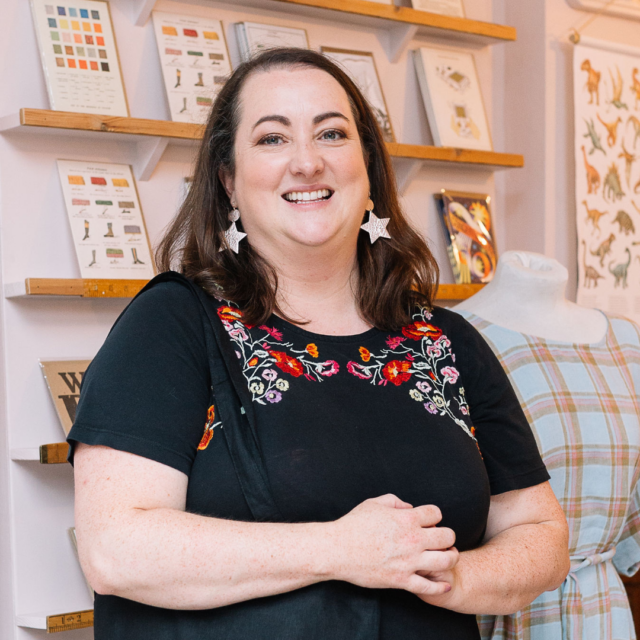The First Golden Rule for Effective Stock Management
Catherine Erdly: Is your cashflow problem really a stock management problem? That’s the question that I’m going to be exploring over the next three episodes of the resilient retail game plan podcast.
Hi, I’m your host, Catherine Erdly. I’m also the founder of the resilient retail club, which is my membership group and mastermind for product businesses. You can find out more at resilientretailclub.com.
And before we jump into today’s episode and answer that question, I want to invite you to follow, subscribe, whatever the word is on the platform that you listen to podcasts on, to this podcast, so that you’ll be the first to know about every new episode that comes out on a Thursday.
If you have a moment to rate a review, then that would be amazing as well. Again, depends on which platform you’re on. But ratings and reviews as well as followers, subscribers have a huge, huge impact on how discoverable a podcast is. So if you have a moment to do that for me, then I would be so appreciative. Thank you so much.
Welcome to the Resilient Retail Game Plan, a podcast for anyone wanting to start, grow or scale a profitable creative product business with me, Catherine Erdly. The Resilient Retail Game Plan is a podcast dedicated to one thing, breaking down the concepts and tools that I’ve gathered from 20 years in the retail industry and showing you how you can use them in your business.
This is the real nuts and bolts of running a successful product business, broken down in an easy, accessible way. This is not a podcast about learning how to make your business look good. It’s the tools and techniques that will make you and your business feel good.
Confidently plan, launch and manage your products and feel in control of your sales numbers and cashflow to help you build a resilient retail business.
Do you have a cash flow problem or do you have a stock management problem?
Catherine Erdly: Anyway, back to the question at hand. Do you have a cashflow problem or do you have a stock management problem?
The reason I asked this question is that recently when I ran the Retail ROAR summit, I asked everyone who signed up what their biggest issues were. And the biggest issue that came up, particularly in people with more than six figure businesses, was their cash flow and people were talking about issues that they were having managing it.
I also recently read a study about how many people in the UK are planning on starting small businesses and the majority of them again, when they talked about their issues, their number one issue was about financial understanding. And within that, their biggest question that they had was around cashflow.
So cashflow I know is a very, very common issue and topic for a lot of business owners. And I would say particularly product business owners. And so my question for you, for your cash flow is how much of that is related to fixed costs in your business, how much is related to for example your overheads going out, your staff costs and things like that which are a significant portion for most people And how much of it is related to how much stock you’ve got because another thing that a lot of people tell me about is something that I call the hamster wheel syndrome.
They say no sooner than money comes in does it feel like it’s going out and therefore that’s why I liken it to being stuck on a hamster wheel because you’re kind of pedaling forward and the sales come in, but then the money goes straight out again. And often when I talk to people and we dig in a little bit more about cash flow and we dig in a little bit more about what’s actually going on and what those payments are that are going out, then often it’s to suppliers.
So people will say things to me like, for example, once I’ve paid all my suppliers, I don’t really have much money left for myself at the end of the month.
I also know as well from working with small and startup independent retailers and brands for the last six years. Now, this is my heading into my sixth year in business, my heading into my seventh year in business.
I’ve been doing this for six years. Then I also know for a fact that a lot of people are chronically underpaying themselves from their business as well. So we have this kind of situation where many, many business owners struggle with cash flow. Many business owners struggle with paying themselves. And in my head or my experience, what this equates to is very often not necessarily a problem with the structure of the business itself in terms of the size of the overheads compared to the sales, although sometimes that is the main issue.
It’s often to do with stock management. The problem with this, what makes it so difficult to solve or so difficult to be aware of perhaps, is that a lot of people believe that the way to get through a cash flow problem is to have more sales. And so everything that they’re doing in their business is focused on I need to get more sales in I need to be growing my online presence.
I need to have them up for my audience I need to be having more sales and then my cash flow issues will go away And as I said, i’m here to being the bearer of bad news here, but we’ll get on to the good stuff later then. What I can tell you is that based on the information that I’ve had, by looking at the responses of people who, for example, who are signing up to the Retail ROAR Summit, is that as you see the people whose revenues are going up, so we’re talking about the people who are in the 100 to 500k mark, or the 500 to a million pound mark, or the million pound plus mark, what we’re seeing there is that those revenues are going up.
But the cashflow issues, if anything, people below 100k are listing their biggest issue as needing more sales and people over 100k are listing their issues as actually having issues with cashflow. So I would say that, of course, we need more sales. Sales growth is important. However, I would strongly suggest that stock management is a really, really important thing to consider if you’re in the space or especially in the space if you’ve grown past six figures and you’re still finding that you have got an issue with your cash flow
So the next three podcasts I’m going to debate three podcasts of this topic the golden rules of stock management because I really feel very passionately about this subject I feel like stock management is one of those things that there is very, very little information out there, particularly for small business owners, particularly for independent retailers.
There just isn’t that much information out there about how do you actually manage your stock? How do you figure out how much you should have? How do you make sure that the stock you do have is working for you? How do you make sure that it is profitable and how do you, What it boils down to, I believe, the stock management really is the secret to how creative ideas make money.
As we know, having lots of creative ideas is probably the easy part. Bringing them to life is more challenging, but the exciting fun part, making them make money, is the bit that most people, some people are naturally very good at, and most people have got a big gap in their knowledge when it comes to this.
And there’s good reasons for it. The reasons that most people have a gap in their knowledge when it comes to stock management is that it’s actually a very, very specific area of knowledge.
Why I understand so much about stock management.
Catherine Erdly: And the reason that I have it is because I spent nearly two decades working in corporate retail. I worked in a team called Merchandising.
So Merchandising was one of the three product teams that there are inside most big retailers. They have a buying team, They have a design team and they also have a merchandising team. Now most people have a pretty good idea, even if they don’t know the exact details and specifics or how incredibly demanding it is, they have a pretty good idea.
They can figure out what the design team do, design things, what the buying team do, act as the commercial barometer for the business, pick up the products that they want and actually work with the manufacturers to have them developed and created. But the merchandising team is the one that most people aren’t as familiar with.
So the way I like to describe the merchandising team is like this. Imagine if you have a shirt. So the merchandising team might tell you, I think based on analysis, it should be blue. The buyer and the designer between them are going to work out exactly what it looks like, what the fabric is made of, most likely.
Although if merchandising can input into that too, if there’s a particular fabric that we’re tracking and then the merchandiser will tell the buyer, this is how much we’re going to sell it for. This is how many you should buy. This is when you should bring it in. And then once it’s arrived into the warehouse, the merchandise is also responsible for the life cycle of that garment.
So, for example, sending it out to stores, analyzing how it’s selling, and then making decisions about promotions and markdown. So, it’s all of the number side of the product cycle. And that’s why when I work with small businesses, that is something when I first started this six years ago, I wondered to myself, I wonder if it’s useful, helpful for small businesses to tap into some of this knowledge and understanding of everything that I’ve learned over the last 10 years when it comes to stock management.
And as it turned out, the answer was yes. Most people who I spoke to who had product businesses or retailers, absolutely. didn’t really know how much stock they should have, how to effectively manage it. And they were very much interested and open to hearing about my experience, which is basically the start of my whole business.
How Tame Your Tiger will help your stock management
Catherine Erdly: And also a lot of it, the theme of my book, Tame Your Tiger. But what I find really interesting about Tame Your Tiger, and another reason I decided to do this podcast now is that it’s been a year since, Over a year now since Taming of the Tiger was published, and I’ve been thinking and reflecting on how that’s been, which is It’s been a phenomenal experience being an author and what I also was reflecting on is the fact that the book actually covers three main areas.
It covers the teeth. So when we talk about the tiger, the product business is a tiger. To carry on the metaphor, we talk about the teeth, which is to do with the bite that your costs take out of your profits. In other words, your profit margins. It talks a lot about the stomach, which is how much you’re feeding your business, otherwise your fixed costs. But then he also talks about the tail, which is all to do with your stock management and hands down, I have to say that area that people bring up to me, that I talk to people about the chapters that I send people to, or the modules that I send people to, and the course that I made from Tamiya Tiger in the Resilient Retail Club, it’s always the stock management modules and chapters I end up talking to people about and when people have come to me because they found the book, then it’s often for that piece or the stock management piece.
And so I really have come to realize that this is a particular subject that first of all, I absolutely love talking about. Stock management is by far my favorite topic. Maybe that makes me dull and boring. Who knows? But it’s also an area that there’s a real lack of information and and it can be transformative.
And I have had people telling me some incredible stories about how the work that we’ve done on their stock, whether that’s through my mastermind, whether that’s through the book itself, working on the book itself, whether that’s through the book itself. going through the course in the Resilient Retail Club, the impact it’s had on them, the way that they’ve been able to pull back their spending, reduce the amount of money that’s going into stock and boost their bottom line is really, really, for me, so exciting, because this is what I want for every product business.
I want you to have the ability to manage your stock effectively and to have more profit as a result. So, That is why we are going to have three podcasts on the subject and I’m going to share my golden rules with you.
Golden Rule of Stock Management #1 – Have a Stock Plan
Catherine Erdly: And so to touch then on the first golden rule of stock management, it’s number one is know how much stock you should have.
This is the question I get asked the most. People say to me, how much stock should I have? Is there a rule of thumb for the amount of stock that I should have? The amount of money I should be, actually, often the way that people pitch the question to me is they say, is there a percentage of the amount of my turnover that I should be putting back into stock?
And my answer is usually that the best way to get a handle on how much stock you should have, and therefore how much you should be spending on stock, is to have a stock plan. And the way that you create a stock plan, well, first of all, if you want all of the details on how to create a stock plan, then do head to wherever you buy your books and buy Tame Your Tiger.
And the other way, and I believe it’s chapter six, the other thing you can do is if you’re a club member and you’re listening to this, you’re a member of the Resilient Retail Club, you can go to the Tame Your Tiger course, which is inside the course portal and you can go to module six, which is about creating a stock plan.
But essentially what a stock plan is, is a framework, a guide, a map. It’s the closest thing you’ll ever get to a crystal ball in your business. And it’s in ways that I will explain later, but it is basically a framework where you work out how much you set yourself an ideal stock amount for you to have every single month.
And the way that you do this to start off with is you work out What your sales plan is per month. You have to start with your sales plan because the answer to the question, how much stock should I have is always, always related to the, to the question, how much do you sell? So you go, you figure out what you’re going to be selling each month and you use that to work out what your ideal closing stock should be at the end of each month.
Now there’s different ways of doing this. The number I often give people is around three months worth of stock. So for example, uh, if you connect three months worth of planned sales, then that’s roughly how much you should be ending your stock on and ending your month stock on. That way you’re pretty covered.
Stock management is all about finding the balance between what’s the least amount of stock that you can have in your business and not miss out on sales. And At the same time, not over commit. So you’ve got too much of your money tied up in stock. So you want it to be lean, but not too lean. So three months might be a really great place to start because nobody really missed out on sales if they had three full months worth of stock in their business.
Unless they were missing key sellers, which is what we’ll touch on next episode But it’s a really good place to start There’s lots of different reasons why three months might not be right for you. First of all, you might have two years worth of stock in your business it’s not unheard of, if you don’t know by the way If you listen to this and you don’t know how much stock you’ve got and how it relates to your Number of months the amount of sales you’ve got and then go and check in fact Why not shoot me a DM on Instagram at resilient retail club and tell me when you look at your stock holding in your business if you look at your total retail value of your stock Then look at average monthly sales.
Tell me how many months worth of stock you have because I would love to know so you have What you want to do is you? You want to have a look at your sales you want to have a look at your stock. Now you if you’ve got two years worth of stock then me telling you that you need to have three months It would it would just be impractical.
You’d have to buy anything for the next year and nine months, but Most people will still need some kind of newness coming in, even if they’ve got a lot of stock. So in that case, if you’ve got far, far too much stock, then the first thing you’re going to need to do is work out, Okay, well, can I start bringing it down?
Can I start reducing it? The other issue you may run into is if you have a physical space, because physical space is It’s not like Ecom. You need to have a certain amount of stock to make it look shoppable. Now, you probably need less stock than you think you do because there are ways of making your shop floor, for example, be, what I call a low density stock layout, which can actually look very nice and very shoppable for customers.
There’s not tons and tons of stock. There’s just enough to look interesting and they can walk around and touch things without fearing they’re going to knock everything over. But you will have a certain amount of stock that you absolutely have to have in. in your business, in your physical space. So that’s something else that you can consider.
But that is the very starting point, is to have yourself a stock plan and to set yourself an ideal stock target for the end of the month. It will really help you shift your thinking. It will really help you start to see your stock, not as an infinite pot that you can just pour your money into, or that you should pour your money into, but instead a specific number that you’re going to hit, which then will start generating specific budgets, the specific amount of money that you can spend each month, which will then really help you understand your outgoings, which helps you understand your cashflow and all of those good things. It will also help you identify if you’ve just frankly got too much stock, and probably go a long way towards answering the question of why your cash flow is tough.
Coming Up Next – What is driving your sales?
Catherine Erdly: So, next time, I’m going to invite you to explore my second golden rule of stock management, which is knowing what is actually driving your sales. Because the great thing about the stock plan is it gives you a number to work towards. But the bad thing about the stock plan is that it doesn’t show you all the ins and outs. It doesn’t show you all the detail of what’s actually going on in your business.
And so there’s lots more that you can dive into to make it make sense. But for now, that’s the thought I’m going to leave you with.
Number one, do you have a cashflow problem or do you have a stock management problem? And number two, do you have a stock plan? Do you have a specific, ideal closing stock number And if not, why not drop me a note if you think that doesn’t work for your business drop me a note I’d love to know i’d love to see if I can change your mind And also number three, how much stock do you have right now?
It’s a good question to ask yourself. So start by asking yourself that question and we will pick up next week with More of my stock management golden rules until next week. See you then
If you’re loving the idea of having a stock plan for your business, but you don’t know where to get started, then I have got something that you’re not going to want to miss. Take a look in the show notes for a link to my new service, which is launching later this year. You’ll be the first to know about it as well as get some bonuses for being on the waiting list.
So go check it out. Go check out the signup link. Be the first to know about my new service, which is going to be helping you manage your stock without having to take any important time out of your day or wrap your head around how to create things like a stock plan. So if that sounds like you, then go check it out.
Until next week. See you then.







